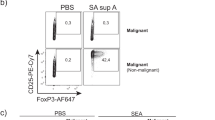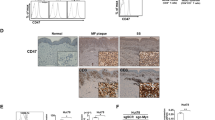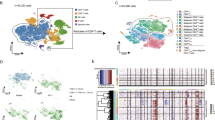Abstract
A characteristic feature of neoplastic transformation is a perpetual activation of oncogenic proteins. Here, we studied signal transducers and activators of transcription (STAT) in patients with mycosis fungoides (MF)/cutaneous T-cell lymphoma (CTCL). Malignant lymphocytes in dermal infiltrates of CTCL tumors showed frequent and intense nuclear staining with anti-PY-STAT3 antibody, indicating a constitutive activation of STAT3 in vivo in tumor stages. In contrast, only sporadic and faint staining was observed in indolent lesions of patch and plaque stages of MF. Moreover, neoplastic lymphocytes in the epidermal Pautrier abscesses associated with early stages of MF did not express activated STAT3. To address the role of STAT3 in survival/apoptosis, CTCL tumor cells from an advanced skin tumor were transfected with either wild-type STAT3 (STAT3wt) or dominant-negative STAT3 (STAT3D). Forced inducible expression of STAT3D triggered a significant increase in tumor cells undergoing apoptosis, whereas forced expression of STAT3wt or empty vector had no effect. In conclusion, a profound in vivo activation of STAT3 is observed in MF tumors but not in the early stages of MF. Moreover, STAT3 protects tumor cells from apoptosis in vitro. Taken together, these findings suggest that STAT3 is a malignancy factor in CTCL.
This is a preview of subscription content, access via your institution
Access options
Subscribe to this journal
Receive 12 print issues and online access
$259.00 per year
only $21.58 per issue
Buy this article
- Purchase on Springer Link
- Instant access to full article PDF
Prices may be subject to local taxes which are calculated during checkout







Similar content being viewed by others
References
Diamandidou E, Cohen PR, Kurzrock R . Mycosis fungoides and Sezary syndrome. Blood 1996; 88: 2385–2409.
Kotz EA, Anderson D, Thiers BH . Cutaneous T-cell lymphoma. J Eur Acad Dermatol Venereol 2003; 17: 131–137.
Samuelson E . Cutaneous T-cell lymphomas. Semin Oncol Nurs 1998; 14: 293–301.
Heim MH . The Jak-STAT pathway: cytokine signalling from the receptor to the nucleus. J Recept Signal Transduct Res 1999; 19: 75–120.
Levy DE, Darnell Jr JE . Stats: transcriptional control and biological impact. Nat Rev Mol Cell Biol 2002; 3: 651–662.
Nielsen M, Kaltoft K, Nordahl M, Ropke C, Geisler C, Mustelin T et al. Constitutive activation of a slowly migrating isoform of Stat3 in mycosis fungoides: tyrphostin AG490 inhibits Stat3 activation and growth of mycosis fungoides tumor cell lines. Proc Natl Acad Sci USA 1997; 94: 6764–6769.
Nielsen M, Kaestel CG, Eriksen KW, Woetmann A, Stokkedal T, Kaltoft K et al. Inhibition of constitutively activated Stat3 correlates with altered Bcl-2/Bax expression and induction of apoptosis in mycosis fungoides tumor cells. Leukemia 1999; 13: 735–738.
Zhang Q, Nowak I, Vonderheid EC, Rook AH, Kadin ME, Nowell PC et al. Activation of Jak/STAT proteins involved in signal transduction pathway mediated by receptor for interleukin 2 in malignant T lymphocytes derived from cutaneous anaplastic large T-cell lymphoma and Sezary syndrome. Proc Natl Acad Sci USA 1996; 93: 9148–9153.
Zhang Q, Raghunath PN, Xue L, Majewski M, Carpentieri DF, Odum N et al. Multilevel dysregulation of STAT3 activation in anaplastic lymphoma kinase-positive T/null-cell lymphoma. J Immunol 2002; 168: 466–474.
Eriksen KW, Kaltoft K, Mikkelsen G, Nielsen M, Zhang Q, Geisler C et al. Constitutive STAT3-activation in Sezary syndrome: tyrphostin AG490 inhibits STAT3-activation, interleukin-2 receptor expression and growth of leukemic Sezary cells. Leukemia 2001; 15: 787–793.
Benekli M, Baer MR, Baumann H, Wetzler M . Signal transducer and activator of transcription proteins in leukemias. Blood 2003; 101: 2940–2954.
Levy DE, Lee CK . What does Stat3 do? J Clin Invest 2002; 109: 1143–1148.
Takeda K, Akira S . STAT family of transcription factors in cytokine-mediated biological responses. Cytokine Growth Factor Rev 2000; 11: 199–207.
Greenhalgh CJ, Hilton DJ . Negative regulation of cytokine signaling. J Leukocyte Biol 2001; 70: 348–356.
Kile BT, Nicola NA, Alexander WS . Negative regulators of cytokine signaling. Int J Hematol 2001; 73: 292–298.
Brender C, Nielsen M, Kaltoft K, Mikkelsen G, Zhang Q, Wasik M et al. STAT3-mediated constitutive expression of SOCS-3 in cutaneous T-cell lymphoma. Blood 2001; 97: 1056–1062.
Bromberg JF, Wrzeszczynska MH, Devgan G, Zhao Y, Pestell RG, Albanese C et al. Stat3 as an oncogene. Cell 1999; 98: 295–303.
Pfeiffer P, Grabau DA, Nielsen O, Clausen PP . Immunohistochemical bulk staining of slides using a rack peroxidase-labelled streptavidin–biotin technique. Appl Immunohistochem Mol Morphol 1996; 4: 135–138.
Kaltoft K, Bisballe S, Dyrberg T, Boel E, Rasmussen PB, Thestrup-Pedersen K . Establishment of two continuous T-cell strains from a single plaque of a patient with mycosis fungoides. In Vitro Cell Dev Biol 1992; 28A (Part 1): 161–167.
Brender C, Nielsen M, Ropke C, Nissen MH, Svejgaard A, Billestrup N et al. Interferon-alpha induces transient suppressors of cytokine signalling expression in human T cells. Exp Clin Immunogenet 2001; 18: 80–85.
Nakajima K, Yamanaka Y, Nakae K, Kojima H, Ichiba M, Kiuchi N et al. A central role for Stat3 in IL-6-induced regulation of growth and differentiation in M1 leukemia cells. EMBO J 1996; 15: 3651–3658.
Nielsen M, Nissen MH, Gerwien J, Zocca MB, Rasmussen HM, Nakajima K et al. Spontaneous interleukin-5 production in cutaneous T-cell lymphoma lines is mediated by constitutively activated Stat3. Blood 2002; 99: 973–977.
Woetmann A, Nielsen M, Christensen ST, Brockdorff J, Kaltoft K, Engel AM et al. Inhibition of protein phosphatase 2A induces serine/threonine phosphorylation, subcellular redistribution, and functional inhibition of STAT3. Proc Natl Acad Sci USA 1999; 96: 10620–10625.
Sano S, Itami S, Takeda K, Tarutani M, Yamaguchi Y, Miura H et al. Keratinocyte-specific ablation of Stat3 exhibits impaired skin remodeling, but does not affect skin morphogenesis. EMBO J 1999; 18: 4657–4668.
Hauser PJ, Agrawal D, Hackney J, Pledger WJ . STAT3 activation accompanies keratinocyte differentiation. Cell Growth Differ 1998; 9: 847–855.
Battle TE, Frank DA . The role of STATs in apoptosis. Curr Mol Med 2002; 2: 381–392.
Bromberg J . Signal transducers and activators of transcription as regulators of growth, apoptosis and breast development. Breast Cancer Res 2000; 2: 86–90.
Chapman RS, Lourenco PC, Tonner E, Flint DJ, Selbert S, Takeda K et al. Suppression of epithelial apoptosis and delayed mammary gland involution in mice with a conditional knockout of Stat3. Genes Dev 1999; 13: 2604–2616.
Minami M, Inoue M, Wei S, Takeda K, Matsumoto M, Kishimoto T et al. STAT3 activation is a critical step in gp130-mediated terminal differentiation and growth arrest of a myeloid cell line. Proc Natl Acad Sci USA 1996; 93: 3963–3966.
Takeda K, Kaisho T, Yoshida N, Takeda J, Kishimoto T, Akira S . Stat3 activation is responsible for IL-6-dependent T cell proliferation through preventing apoptosis: generation and characterization of T cell-specific Stat3-deficient mice. J Immunol 1998; 161: 4652–4660.
Fukada T, Hibi M, Yamanaka Y, Takahashi-Tezuka M, Fujitani Y, Yamaguchi T et al. Two signals are necessary for cell proliferation induced by a cytokine receptor gp130: involvement of STAT3 in anti-apoptosis. Immunity 1996; 5: 449–460.
Catlett-Falcone R, Landowski TH, Oshiro MM, Turkson J, Levitzki A, Savino R et al. Constitutive activation of Stat3 signaling confers resistance to apoptosis in human U266 myeloma cells. Immunity 1999; 10: 105–115.
Grandis JR, Drenning SD, Zeng Q, Watkins SC, Melhem MF, Endo S et al. Constitutive activation of Stat3 signaling abrogates apoptosis in squamous cell carcinogenesis in vivo. Proc Natl Acad Sci USA 2000; 97: 4227–4232.
Acknowledgements
This work was supported in part by the Danish Allergy Research Center, the Danish Research Councils, the Danish Biotechnological Center for Cellular Communication, the Novo Nordic Foundation, Fabrikant Vilhelm Pedersen og hustrus mindelegat, the Danish Medical Research Council (Det Sundhedsvidenskabelige Forskningsråd), the Danish Cancer Research Foundation (Dansk Kræftforsknings Fond), the Danish Cancer Society (Kræftens Bekæmpelse), the Alfred Benzon Foundation, the Dannins Foundation (Ingeborg og Leo Dannins Legat for Videnskabelig Forskning), The Johann Weiman f. Seedorff and Wife Foundation (Købmand i Odense Johann og Hanne Weimann f. Seedorff's Legat), the Carlsberg Foundation, the University of Copenhagen, PhD programme (for AW, CB, CGK, KWE), scholarship from The Danish Cancer Society (Kræftens Bekæmpelse) (for VHS), and the US National Cancer Institute.
Author information
Authors and Affiliations
Corresponding author
Rights and permissions
About this article
Cite this article
Sommer, V., Clemmensen, O., Nielsen, O. et al. In vivo activation of STAT3 in cutaneous T-cell lymphoma. Evidence for an antiapoptotic function of STAT3. Leukemia 18, 1288–1295 (2004). https://doi.org/10.1038/sj.leu.2403385
Received:
Accepted:
Published:
Issue Date:
DOI: https://doi.org/10.1038/sj.leu.2403385
Keywords
This article is cited by
-
The polymorphisms of IL-6/STAT3 signaling pathway may contribute to cutaneous T-cell lymphomas susceptibility
Archives of Dermatological Research (2021)
-
Peripheral T cell lymphomas: from the bench to the clinic
Nature Reviews Cancer (2020)
-
Current Status of HDAC Inhibitors in Cutaneous T-cell Lymphoma
American Journal of Clinical Dermatology (2018)
-
T-cell lymphomas, a challenging disease: types, treatments, and future
International Journal of Clinical Oncology (2017)
-
Malignant inflammation in cutaneous T‐cell lymphoma—a hostile takeover
Seminars in Immunopathology (2017)



